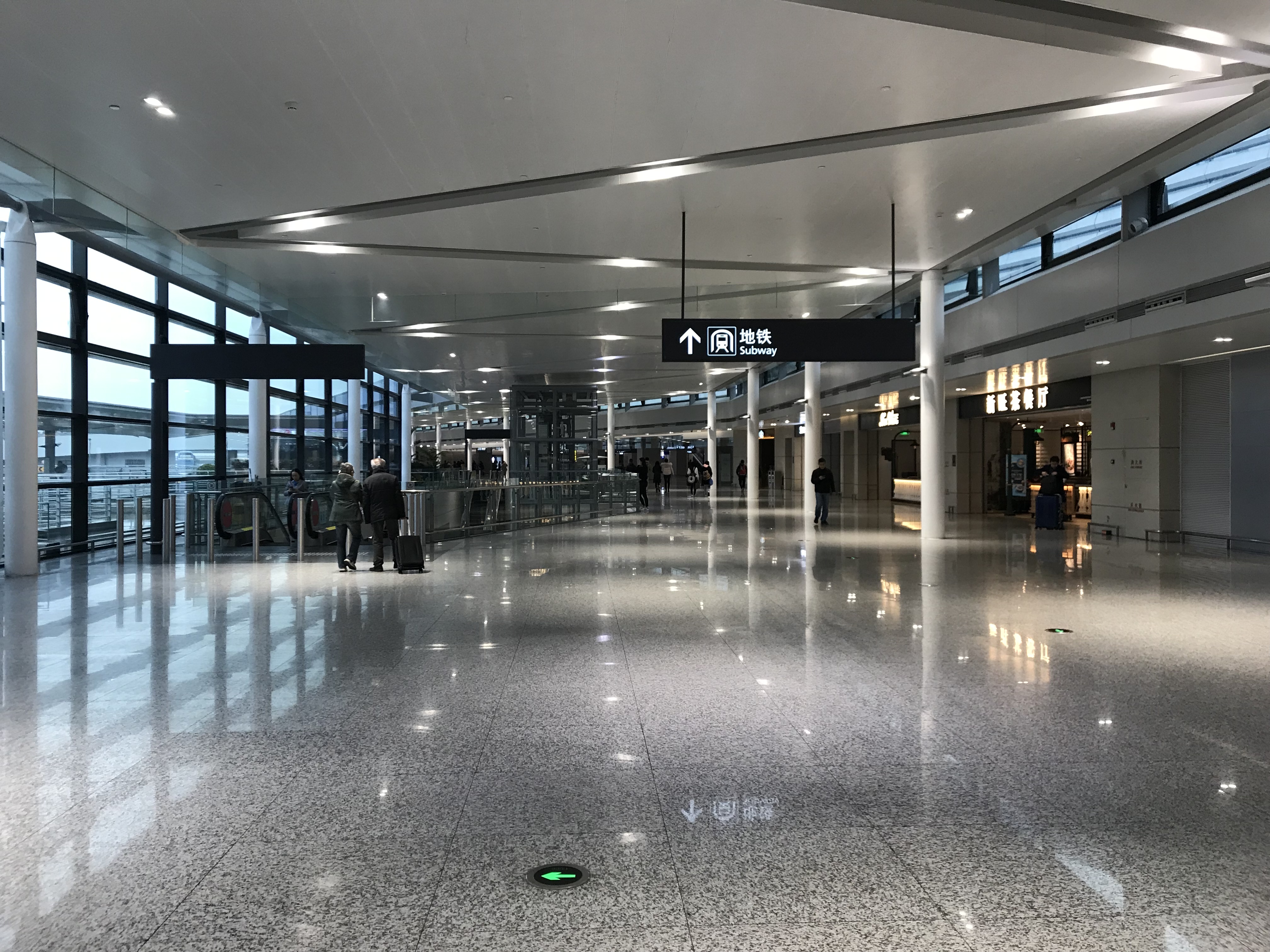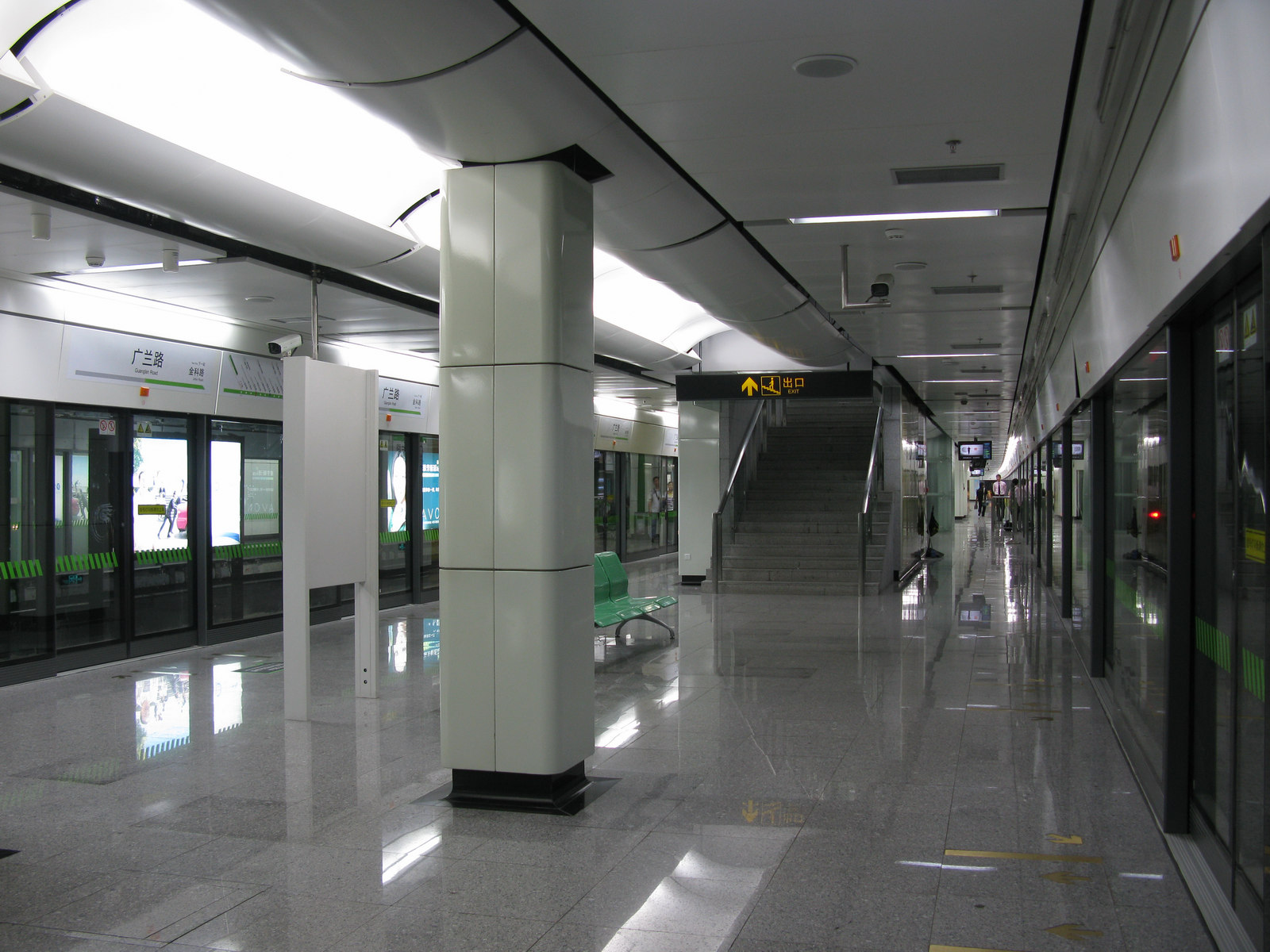|
Line 2, Shanghai Metro
Line 2 is an east–west line in the Shanghai Metro network. With a length of nearly , it is the second longest line in the metro system after line 11. Line 2 runs from National Exhibition and Convention Center in the west to in the east, passing Hongqiao Airport, the Huangpu river, and the Lujiazui Financial District in Pudong. With a daily ridership of over 1.9 million, it is the busiest line on the Shanghai Metro. The eastern portion of the line, - Pudong International Airport section, was operated as an independent service route until April 19, 2019, when through service began. The line is colored light green on system maps. History The first section of line 2 was opened on October 28, 1999, from to . This section, which included 12 stations, totaled . A year later coinciding with the tenth anniversary of the development and opening up of Pudong, marking the official opening of the line, was added to the eastern part of the line, adding . Four new stations, located west o ... [...More Info...] [...Related Items...] OR: [Wikipedia] [Google] [Baidu] |
Beixinjing Station
Beixinjing () is a Metro station, station on Line 2 (Shanghai Metro), Line 2 of the Shanghai Metro in Changning District. It is part of the western extension of that line from to that opened on 30 December 2006. It is within walking distance of the Brilliance West shopping mall. References Line 2, Shanghai Metro Shanghai Metro stations in Changning, Shanghai Railway stations in China opened in 2006 2006 establishments in Shanghai {{Shanghai-railstation-stub ... [...More Info...] [...Related Items...] OR: [Wikipedia] [Google] [Baidu] |
Hongqiao Airport
Shanghai Hongqiao International Airport is one of two international airports serving Shanghai, China. The airport is located near the town of Hongqiao in the outskirts of Changning and Minhang districts, west of downtown, and is closer to the city center than Shanghai–Pudong. Hongqiao Airport is the corporate headquarters and a major hub for China Eastern Airlines, Shanghai Airlines, and Juneyao Air, as well as a major hub for Spring Airlines. In 2023, Hongqiao Airport handled 42,492,745 passengers, making it the 7th busiest airport in China and the 43rd busiest in the world. By the end of 2011, Hongqiao Airport hosted 22 airlines serving 82 scheduled passenger destinations. Shanghai Hongqiao Airport was also certified with the Skytrax 5-Star Airport Rating for facilities, terminal comfort and cleanliness, shopping, food & beverages, and staff service in 2019. Hongqiao Airport served as Shanghai's primary airport until the completion of Pudong International Airpor ... [...More Info...] [...Related Items...] OR: [Wikipedia] [Google] [Baidu] |
Cross-platform Interchange
A cross-platform interchange is a type of Interchange station, interchange between different lines at a metro (or other railway) station. The term originates with the London Underground; such layouts exist in other networks but are not commonly so named. In the United States and Canada, it is often referred to as a cross-platform transfer. This configuration occurs at a station with island platforms, with a single platform in between the tracks allocated to two directions of travel, or two side platforms between the tracks, connected by level corridors. The benefit of this design is that passengers do not need to use stairs to another platform level for transfer. A cross-platform interchange arrangement may be costly to build due to the complexity of rail alignment, especially if the railway designers also arrange the track with overpass, flyovers (which is typically done to increase efficiency). A typical bidirectional cross-platform interchange configuration consists of two ou ... [...More Info...] [...Related Items...] OR: [Wikipedia] [Google] [Baidu] |
Shanghai Public Transportation Card
The Shanghai Public Transportation Card (SPTC) ( also known as ) is a contactless card, utilising RFID technology, which can be used to access many forms of public transport and related services in and around Shanghai. Shanghai public transportation card is also provided in the form of Apple Pay as well as QR codes, which are accessible through WeChat, Alipay, APPs and miniprograms, and enjoy the same price discounts as cards. Uses The SPTC is a form of rechargeable cash card, and allows access to, among other things in Shanghai: *Metros *Airport maglev *Trams *Buses and trolleybuses *Ferries *Taxis *Tourist centers *Car parks *Fuel stations *Expressways *Auto repair service However, often taxis are driven by a driver other than the registrant of the vehicle and they would turn down the Card. Among the list above, metro, maglev, trams, buses, trolleybuses and ferries also accept Shanghai Public Transportation QR codes. Shanghai's latest transportation card (red backgroun ... [...More Info...] [...Related Items...] OR: [Wikipedia] [Google] [Baidu] |
Line 10 (Shanghai Metro)
Line 10 is a southwest–northeast line of the Shanghai Metro network that opened for service on April 10, 2010. The line runs from to , with a branch line from to . It has been given the unofficial nickname “Golden Line” as it links many of the city's tourist attractions like Yuyuan and Xintiandi. It connects the Hongqiao International Airport with the downtown core of Shanghai, and also the dense residential districts of Yangpu and Hongkou. It is the only line in the system with numbered station codes. It is the first high-density and high-volume fully automatic subway line in mainland China, operating with GoA4 unattended train operation. The line is colored lilac on system maps. History The first phase opened on 10 April 2010 and extended on 30 November 2010. The second phase of the line, a northern extension from to , which crosses underneath the Huangpu River and provide residents of northern Pudong with easier access to parts of Yangpu District and Hongkou Dist ... [...More Info...] [...Related Items...] OR: [Wikipedia] [Google] [Baidu] |
Shanghai Hongqiao Railway Station
Shanghai Hongqiao (; Shanghainese: ''Zånhae Ghonjio Zae'') is one of the most prominent of the main railway stations in Shanghai, China - the others being Shanghai railway station, Shanghai South railway station and Shanghai West railway station. Shanghai Hongqiao railway station, located in Minhang District of Shanghai, is a major part of the Hongqiao Comprehensive Transportation Hub (“the Hongqiao hub”). The station is next to Terminal 2 of Shanghai Hongqiao International Airport and lines 2, 10, and 17 of Shanghai Metro. Overview The construction of the railway station began on 20 July 2008 with a total investment of more than CNY 15 billion ($2.3 billion). It was opened on 1 July 2010, simultaneously with the opening of the Shanghai–Nanjing intercity railway line. The railway station takes a total area of about and has 16 platforms, most of which are high-speed-rail configuration. The main building of the train station measures in length, in width, and high ( ... [...More Info...] [...Related Items...] OR: [Wikipedia] [Google] [Baidu] |
Island Platform
An island platform (also center platform (American English) or centre platform (British English)) is a station layout arrangement where a single platform is positioned between two tracks within a railway station, tram stop or transitway interchange. Island platforms are sometimes used between the opposite-direction tracks on twin-track route stations as they are cheaper and occupy less area than other arrangements. They are also useful within larger stations, where local and express services for the same direction of travel can be accessed from opposite sides of the same platform instead of side platforms on either side of the tracks, simplifying and speeding transfers between the two tracks. The historical use of island platforms depends greatly upon the location. In the United Kingdom the use of island platforms on twin-track routes is relatively common when the railway line is in a cutting or raised on an embankment, as this makes it easier to provide access to the platf ... [...More Info...] [...Related Items...] OR: [Wikipedia] [Google] [Baidu] |
Qingpu District, Shanghai
Qingpu District, is a suburban district of Shanghai, Shanghai Municipality. Lake Dianshan is located in Qingpu. The population of Qingpu was counted at 1,271,424 people in the 2020 Census. It has an area of . Qingpu District is the westernmost district of Shanghai Municipality; it is adjacent to Jiangsu and Zhejiang Provinces. Around the lake are a number of tourist scenic areas, all complete in tourist facilities. Among the tourist areas is the waterside town Zhujiajiao, a major tourist destination in the Shanghai region. There are currently 21 domestic travel services, three international travel business departments, 14 star-rated hotels, and 3 Tourist Attraction Rating Categories of China, AAAA-grade tourist spots in Qingpu District. Transport * Line 17 (Shanghai Metro) * China National Highway 318 Tourism Qingpu's tourist attractions include the Zhujiajiao Ancient Town, Oriental Land, Jinze Ancient Town, Lake Dianshan, and the Qushui Garden. Economy The China of ... [...More Info...] [...Related Items...] OR: [Wikipedia] [Google] [Baidu] |
Pudong International Airport Station
Pudong Airport Terminal 1&2 (), formerly Pudong International Airport () is a railway, metro and maglev station located within Shanghai Pudong International Airport in Shanghai. It serves as both the eastern terminus of both the Shanghai maglev train, having opened to trial operations on 31 December 2002, and, since an eastern extension from opened on 8 April 2010, the eastern terminus of Line 2 of the Shanghai Metro The Shanghai Metro (; Shanghainese: ''Zaon6he5 Di6thiq7'') is a rapid transit system in Shanghai, operating urban and suburban transit services to 14 of its 16 List of township-level divisions of Shanghai, municipal districts and to the neighb .... Although the metro and maglev stations are in the same property, they have distinct fare-paid zones, as their fare systems are separate. The currently under construction Airport Link line will include this station as an intermediate stop. To match the station of Airport link line, the station was renamed on 21 S ... [...More Info...] [...Related Items...] OR: [Wikipedia] [Google] [Baidu] |
Guanglan Road Station
Guanglan Road () is an interchange station between Line 2 and Line 21 of the Shanghai Metro. The station is located along Zuchongzhi Road and is located between the stations of and the on Line 2. The station is located east of the intersection between Zuchongzhi Road and Guanglan Road, and has four exits. The station was opened on 24 February 2010, after Line 2 was extended from . The station has 3 tracks (5 when Line 21 is complete), 1 island platform(2 when Line 21 is complete), and a side platform. Line 2 Trains heading to National Exhibition and Convention Center use the line 2 island platform and trains heading to Pudong Airport Terminal 1&2 use the side platform, while Line 21 uses another set of island platforms when built. History By 2008, the Line 2 terminated at the station. On 24 February 2010, the line was expanded from this station through the station to the Guanglan Road station. Two months later, the line was extended past this station through , , , , , ... [...More Info...] [...Related Items...] OR: [Wikipedia] [Google] [Baidu] |
2010 Shanghai World Expo
Expo 2010, officially the Expo 2010 Shanghai China, was held on both banks of the Huangpu River in Shanghai, China, from 1 May to 31 October 2010. It was a major World Expo registered by the Bureau International des Expositions (BIE), in the tradition of international fairs and expositions, the first since 2005. The theme of the exposition was ''"Better City – Better Life"'' and signifies Shanghai's new status in the 21st century as the "next great world city". The Expo emblem features the Chinese character ('world', Chinese "shì") modified to represent three people together with the 2010 date. It had the largest number of countries participating and was the most expensive Expo in the history of the world's fairs. The Shanghai World Expo was also the largest World's Fair site ever at 5.28 square km. By the end of the expo, over 73 million people had visited – a record attendance – and 246 countries and international organizations had participated. On 16 October 201 ... [...More Info...] [...Related Items...] OR: [Wikipedia] [Google] [Baidu] |







